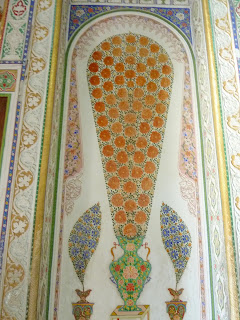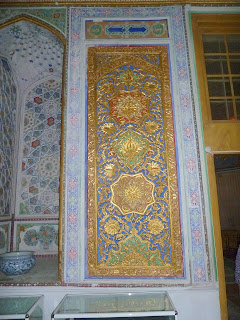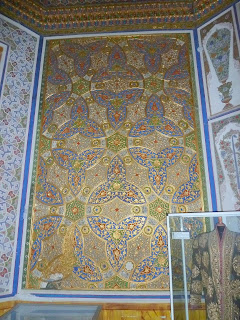Bukhara was
one of the main centres of world civilisation from its early days in 6th C
BC. Turkic speakers gradually moved in. Its architecture and archaeological
sites form one of the pillars of Central Asian history and art. The Bukhara and
its surrounds were part of the Persian Empire.
Bukhara
was the last capital of the Emirate of Bukhara. It was besieged by the Red Army during the
Russian Civil War. In 1920, an army of well-disciplined and well equipped Red Army troops
under the command of General Frunze, attacked the city. On 31 August 1920,
the Emir fled to Dushanbe now in Tajikistan. On 2 September
1920, after four days of fighting, the emir’s citadel was destroyed, the red
flag was raised from the top of the
famous Kalyani minaret.
In the
mid-XIX century Emir of Bukhara Nasrullah Khan decided to build a new country
seat for himself. To choose the coolest place not to suffer from summer heat,
the architects made recourse to an old method - dressed muttons were put on the
potential sites of construction. The place, where the meat got spoiled last,
was chosen for the construction of the suburban pearl of Bukhara.
Unfortunately, this palace did not survive to the present day.
 Several
decades later, another emir of Bukhara Mir Sayyd Muhammad Alim Khan initiated
the construction of a new palace there. A legend has it that, Emir devoted the
palace to his wife Sitora. The construction work which lasted several years
resulted in the residence of unprecedented beauty. The Bukhara architects
having trained in Russia managed to combine oriental and western styles in
their creation. After a while the Emir’s wife died, and her name was given to
the palace. It was named Sitorai Mokhi-Khosa, translated from Tajik as “Star,
like the Moon”, and this name was preserved to this day. Unfortunately, the
Sitorai Mokhi-Khosa also shared the fate of the first palace – it was
destroyed.
Several
decades later, another emir of Bukhara Mir Sayyd Muhammad Alim Khan initiated
the construction of a new palace there. A legend has it that, Emir devoted the
palace to his wife Sitora. The construction work which lasted several years
resulted in the residence of unprecedented beauty. The Bukhara architects
having trained in Russia managed to combine oriental and western styles in
their creation. After a while the Emir’s wife died, and her name was given to
the palace. It was named Sitorai Mokhi-Khosa, translated from Tajik as “Star,
like the Moon”, and this name was preserved to this day. Unfortunately, the
Sitorai Mokhi-Khosa also shared the fate of the first palace – it was
destroyed.
The current
Sitorai Mokhi-Khosa Palace was built in 1912-1918, by order of the last Emir of
Bukhara Mir Sayyd Muhammad Alim Khan. The construction involved the best
Bukhara masters of the time, along with two Russian engineers Margulis and
Sakovitch.
 The
palace main building consists of several reception halls and emir’s private
rooms. Special attention was given to White Hall, see below, decorated by the famous
master Usto Shirin Muradov who was subsequently perpetuated in a monument
installed in the territory of the summer residence. White Hall was decorated
with ganch, laid on walls covered with mirrors. None of the patterns was repeated. It is worth pointing out that mirrors in the Sitorai Mokhi-Khosa Palace are
used everywhere, quite liberally. You can see Venetian mirrors, Japanese mirrors set in
fancy frames, and even trellis, which creates a reflection, repeated 40 times. In
addition, the summer palace includes a tea room, small minaret, and guest
house, richly incrusted with gold braid. Each place has its own story and
legends.
The
palace main building consists of several reception halls and emir’s private
rooms. Special attention was given to White Hall, see below, decorated by the famous
master Usto Shirin Muradov who was subsequently perpetuated in a monument
installed in the territory of the summer residence. White Hall was decorated
with ganch, laid on walls covered with mirrors. None of the patterns was repeated. It is worth pointing out that mirrors in the Sitorai Mokhi-Khosa Palace are
used everywhere, quite liberally. You can see Venetian mirrors, Japanese mirrors set in
fancy frames, and even trellis, which creates a reflection, repeated 40 times. In
addition, the summer palace includes a tea room, small minaret, and guest
house, richly incrusted with gold braid. Each place has its own story and
legends.
 In 1927,
shortly after the fall of the Emirate of Bukhara, the palace was transformed
into a museum. Its exposition was periodically changed. But today, it houses
the Museum of Arts and Crafts. The exhibition includes palace furniture of the
XIX-XX centuries, jewelry and golden-embroidered products made by Bukhara
masters, objet d’art from Russian and Japanese porcelain of XIV-XX centuries.
In 1927,
shortly after the fall of the Emirate of Bukhara, the palace was transformed
into a museum. Its exposition was periodically changed. But today, it houses
the Museum of Arts and Crafts. The exhibition includes palace furniture of the
XIX-XX centuries, jewelry and golden-embroidered products made by Bukhara
masters, objet d’art from Russian and Japanese porcelain of XIV-XX centuries.Over the past century Bukhara has considerably expanded, and nowadays the Sitorai Mokhi-Khosa Palace is located as close as four km to the city outskirts. The residence of the last Emir of Bukhara, where, today as a hundred years ago, it salutes the visitors in the reflections of its former magnificence, as though still available to receive royalties and overseas ambassadors.


Strolling
around the palace grounds, I saw the poorly maintained outer structures whereas
inside, ancient gems were displayed beautifully. The entry to the Palace is
through a arch and a gate and one would never dream that a palace lay beyond,
hidden somewhere as the grass lies
uncut, the paving is all over, the paths are uneven and the fencing inside
often broken. There are a few peacock babies in cages - away from feral cats
presumably. At the far end, in a small white building, you see a minaret which
was the Emir’s private prayer area and opposite that a group of ladies
gossiping. On our arrival, they immediately took out carpets and fabrics – we were
not interested as we had come to see the hidden gems inside – the array of exquisitely
crafted suzani took our breath away. The only other place where we saw such
incredible embroidery and fabrics was in Tashkent at the Museum of Fine Art.


Bukhara
is also one of the most ancient cities of Uzbekistan, situated on a sacred
hill, the place where sacrifices were made by fire-worshippers in springtime.
This city was mentioned in a holy book "Avesto". Bukhara city is
supposed to be founded in the 13th C B.C. during the reign of
Siyavushids who came to power 980 years before Alexander the Great. The name of
Bukhara originates from the word "vihara" which means
"monastery" in Sanskrit. The city was once a large commercial center
on the Great Silk Road. Bukhara lies west of Samarkand and was once a center of
learning renowned throughout the Islamic world. It is the hometown of the great
Sheikh Bakhouddin Nakshbandi. He was a central figure in the development of the
mystical Sufi approach to philosophy, religion and Islam. In Bukhara there are
more than 350 mosques and 100 religious colleges. Its fortunes waxed and waned
through succeeding empires until it became one of the great Central Asian
Khanates in the 17th century.
So,
aside from the Summer Palace, go visit as many of these monuments as you can
when in this beautiful city. Its the Rome of the Silk Route.
Text and photographs copyright of the author. No part of this article or photographs maybe transmitted or reproduced by any means, electronic, mechanical, photocopying or otherwise, without written permission. Do contact the author on email -- helpthesun@gmail.com














No comments:
Post a Comment
Text and photographs are copyright of the author. No part of any article or photographs maybe transmitted or reproduced by any means, electronic, mechanical, photocopying or otherwise, without written permission. Do contact the author on email -- helpthesun@gmail.com